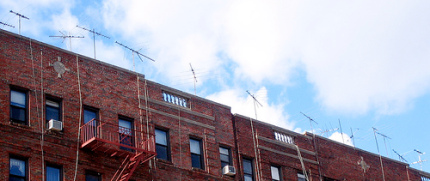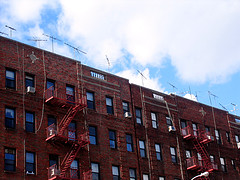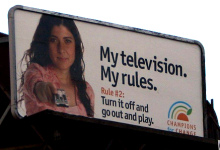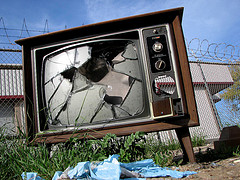Stated Meeting: Green Carts Come to Town
Though it scaled back a bill to create green carts, the City Council approved legislation Wednesday creating this new class of street vendor.
In neighborhoods where residents have little access to fruits and vegetables, carts with produce from lettuce to bananas will be allowed to offer residents healthier options. The bill raised fierce opposition from produce and supermarket associations throughout the city.
In addition to the green cart legislation, the council unanimously approved legislation providing a tool for tenants to sue landlords for harassment.
Fruits on the Streets
The green cart legislation (Intro 665) was spearheaded by Mayor Michael Bloomberg and introduced by Council Speaker Christine Quinn. Despite that support, the bill was approved by a vote of 37 to 9 – a relatively divided vote for the City Council.
The bill also was scaled back since it was introduced in December. Initially it proposed to increase the city’s vending permits by 1,500. Now the legislation adds 1,000. There are currently about 3,000 food vendor permits in the city.
The approved version of the bill decreased the number of police precincts where the permits can be used in from 43 to 34. Most of the districts that were dropped are in Queens.
Quinn said the reductions would make the bill being more targeted, and were not indicative of opposition to the carts in certain council districts. The bill had initially applied to neighborhoods where 12 percent of the population or more had not had a serving of fruits or vegetables in the last 24 hours based on a survey by the Department of Health and Mental Hygiene. The legislation increased that cap to 15 percent, thus reducing the number of areas affected by the bill.
Business groups and grocery associations, including the National Supermarket Association and the Korean Produce Association, opposed the legislation because they said it threatened small businesses. If green carts were permitted to set up like other vendors – who can go within 20 feet of a any business – many would lose customers, they argued.
Such conflicts would arise, they say, because the legislation is not based on the number of stores offering produce in these neighborhoods, which are mostly in the Bronx and Brooklyn, but on the consumption of fruits and vegetables.
Other business associations argued the city’s street vendor permits are not enforced already, and that adding a new class would complicate the system and threaten established businesses.
Members who voted against the legislation voiced similar concerns. “You have to open the entire city’s streets,” said Councilmember Melinda Katz, who voted against the bill. “My issue is enforcement is impossible.”
Some also claimed the legislation was fast tracked through City Hall to avoid opposition groups. Quinn said the city gave the bill ample review, and they wanted to ensure green vendors could be on street corners by this spring and summer – the height of the fruit and vegetable season.
Tenant Harassment
Though the city’s tenant harassment legislation, (Intro 627) which was introduced by Councilmember Daniel Garodnick, was approved unanimously, it also caused controversy at City Hall Wednesday.
Since the bill was introduced in December, Councilmember Leroy Comrie introduced legislation, which would have allowed landlords to take tenants to court for harassment. Though that bill had little chance of receiving widespread support within the City Council, some members wanted to ensure landlords were protected from frivolous lawsuits from tenants.
Comrie said he voted in favor of the tenant harassment legislation out of respect for other members of the City Council. He still questions the absence of an independent third party who can verify whether harassment really occurred.
According to the legislation, a Housing Court judge would have to approve a harassment claim in order for a tenant to file a suit against a landlord who has had three suits dismissed within the last ten years. The measure would also qualify landlords for attorney fee reimbursement if the claim were thrown out.
Supporters of the legislation say it provides protection for tenants and answers, at least in part, the critical housing crisis in the city. Garodnick said over the years the city has seen an increase in such tactics, and the legislation hopes to reverse the trend.
Tenants could bring a landlord to Housing Court for harassment for the following violations: interruptions of essential services for an extended period, damaging locks or doors, using frivolous court proceedings or other measures aimed at encouraging or forcing a tenant to vacate an apartment.
If found guilty of harassment, a landlord could pay between $1,000 and $5,000 in civil penalties. Â
Counting Down to the Great Television Turnover

One year from now, a New Yorker's television will suddenly stop working. More likely, a great many New Yorkers' televisions will stop working. It's hard to say who they will be, but they will probably think they are alone. They are likely to be older residents, with limited formal education, living on low fixed incomes, who do not speak English. Some will be residents of cavernous blocks, on lower floors in the shadow of a large building or behind a thick tree cover. We don't know who they will be, but some of the hundreds of thousands of New Yorkers who get free television over the airwaves will lose their signal.
Though many New Yorkers don't yet know it, the clock is ticking on their television reception. The federal government has set Feb. 17, 2009, as the date on which television broadcasters must switch from an analog signal to a digital one. This change means anyone with a television set more than a couple of years old who wants to keep getting free broadcasts over the air needs to take action.
The transition to digital television, which was mandated by Congress in 2005, will free up portions of the airwaves for new uses (digital transmission uses narrower slices of the spectrum than analog) and enhance data services like closed captioning. Viewers who make a smooth transition to digital television (DTV) should see more channels with clearer reception.
To make a smooth transition, however, any television set that relies on analog signals will need a converter installed between the set and the antenna. Using money from the sale of portions of the newly freed up airwaves, Congress has set aside $1.5 billion to subsidize the purchase of digital converters with coupons that will make the cheapest converters nearly free. Converter coupons won't be enough to keep everyone's television working, however.
Two recent, independent reports suggest that the government-mandated transition process will leave many viewers without a signal. The reports suggest that there are many places where this transition could go wrong. While they lay the blame on the government, at this point individual consumers need to take action.
Weak Signals
To get converters, though, consumers have to know they need them. Many, though, don't know that the transition is coming. For all of the money the government is spending on coupons, they plan to spend just $27.5 million on public education. The United Kingdom, by contrast, has budgeted $400 million to inform a population one-fifth the size. "The federal government is relying very heavily on industry to educate consumers and that's resulting in a large amount of confusion over what consumers should do to prepare," says Joel Kelsey, Grassroots Coordinator for Consumers Union. Consumers Union's publication Consumer Reports recently launched a comprehensive guide to the transition.
If you have seen a public service announcement about the digital television transition, it was probably sponsored by the DTV Transition Coalition, a consortium of cable, broadcast and consumer electronics industry groups. The industry-sponsored effort, valued at $697 million, does not explain all of the issues though.
Nielsen Data assessed by Consumer Reports ranked the New York City metropolitan area sixth in the country in terms of sheer number of households currently getting their only television signal free over the airwaves: Almost 357,000 New York City households depend entirely on over-the-air television signals. Though these households comprise less than 5 percent of those that own televisions in the city -- much lower than the national average of 15 percent -- they are overwhelmingly low income, elderly and isolated: They are both vulnerable and hard to reach.
Among the issues not being fully addressed: what happens to cable or satellite subscribers whose service goes out or gets shut off? Consumers Union found in their polling that many pay television consumers indicated they would be very concerned if they were unable to receive an over the air signal during an emergency. If a storm knocks out cable service in your neighborhood, anyone with only an analog television will be left without a signal until the cable company repairs the lines. Households that might be thinking of cutting the expense of cable out of already tight budgets won't be able to turn off their service and still watch the news if they don't get a converter.
Even if every American television viewer gets the message and acquires and installs a converter, some will still have technical difficulties. "It's a systems issue," says Barry Goodstadt, senior vice president of research for Centris, which conducts independent telecommunications research and recently released a report on gaps in digital television coverage. Centris found as many as 580,000 households in our region that stand to be affected by the transition, homes that have and use multiple televisions, some of which rely on the airwaves for their signal. Moreover, as Centris points out, the converter box is just one piece of the puzzle. "The problem," Goodstadt says, "is that the converter box is only as good as the antenna it's hooked up to."
Straight Signals

Unlike analog signals, which can bounce down different paths to your TV or fade out over long distances, digital signals don't go static; either you see it or you don't. Traditional television-top "rabbit ears" may not be able to pick up the digital signal. Centris' phone surveys found that nearly 80 percent of Americans who receive their television signal free over the airwaves have only set-top antennas. This could create large gaps in digital television signals' reach, though it remains hard to know how many households will be affected. Centris will be conducting surveys and tests in New York and other cities over the next two months. The Federal Communications Commission and industry groups have disputed Centris' conclusions, offering somewhat rosier alternative assessments.
No matter who you believe, some households will need both a converter box and to upgrade from rabbit ears to a rooftop antenna. In some cases, existing rooftop antennas will need upgrades. Installing or upgrading a rooftop antenna means running electricity and coaxial cable to the roof. However, as the Centris team points out, the public education campaigns do not even mention the word "antenna."

"That is why we brought this stuff up," says Goodstadt. "We don't want consumers to have a horrible experience going through this transition. And if we ignore the antenna issue, some people will. There are some costs and issues that the government simply is not recognizing."
Potential for Abuse
If the process is bungled, it could turn into a boon for cable and satellite providers as long-time holdouts give up trying to tune in free TV. Anyone who sells or installs antennas or converter boxes should also fare well. But whether households switch to cable, upgrade antennas, replace their television sets, or acquire converter boxes, the money for all of these solutions is ultimately going to come from the consumer. As Kelsey puts it, "Consumers who didn't ask for a switch to digital television are now being required to spend a huge amount of money on a box and an antenna to watch free TV broadcast over public airwaves."
A situation where people know they need to spend money, but not exactly on what, is ripe for fraud. New Yorkers who don't speak English may miss most advertisements, and those who are afraid to interact with the government will not be able to claim their converter box coupons. An unscrupulous landlord could also acquire the coupons for all of his tenants and then sell the cards or use them to buy converters to sell. Cable subscribers who don't need a converter, could do the same thing.
Added Costs
One potential cost will be to the environment. A Consumers Union survey found that nearly a quarter of consumers who are aware of the transition believe they will need to throw out their analog televisions after 2009. "This would mean thousands of perfectly good televisions getting kicked to the curb," Kelsey worries, "resulting in an immense amount of dangerous electronic waste" -- something New York City already has enough of.
There is another option: one survey conducted by the cable industry in November found that many households plan to keep their obsolete televisions for DVD watching or to give up television entirely.
Are NYC Broadcasters Ready?

The final link in the DTV transition chain is the broadcasters themselves. Some smaller broadcasters are asking the FCC for a waiver that will allow them to shut off analog broadcasts before the deadline, which would mean that viewers without a digital setup would lose those channels early. Smaller, low-power TV stations do not have to meet the deadline and may not have a digital signal come next February; viewers will lose those channels unless they have a "pass through" converter box that can handle both kinds of signals.
New York's major broadcasters are already transmitting digital signals and will continue analog broadcasts until the cutoff, but some have complicated plans to switch channels over the course of a couple of days or even minutes.
"We're ready to go," said one engineer at WNYW, the local Fox affiliate that broadcasts from the top of the Empire State Building. Though he's certainly the station's expert on this topic, he's not an official company spokesperson so he asked to remain anonymous. He thinks some of the city's stations are further along in their preparations than others, but "by the time we get to February '09, New Yorkers will be alright."
The WNYW engineer and his colleagues have been from midtown to Long Island testing reception. He's found newer digital TVs to be much better at picking up a signal than the first generation of digital TVs that are three or four years old now, but he sees the transition as a government-mandated process of trial and error. He's concerned that the regulators and politicians won't respond quickly to the feedback from the engineers. No amount of preparation or technological enhancement can ensure that no New Yorkers lose their signal and do not know what to do about it.
So, What Are You Waiting For?
Goodstadt and Kelsey both offer the same advice to New Yorkers who are concerned that they might lose their television signal: Don't wait. Get your coupons, get your converter box, set it up, and see if it works.
Joshua Breitbart is policy director for People's Production House.
Â
A Permanent Address: Regulating Residency Requirements at the City Council
Last year, Councilmember Mathieu Eugene was elected three times: Once in February, once in April and once in November. The reason: his address.
When the seat became vacant in January of 2007, Eugene lived in Canarsie, far beyond the Central Brooklyn district's borders. He later moved to a leased apartment in Prospect Park South, well within the district's borders. The question was whether he moved in time.
The controversy over his residence sent Brooklynites to and from the polls, elicited advice from the state attorney general and sparked a discussion on how long elected officials should live in their district before seeking office.
Different offices, from local to state to federal, have different requirements. And ironically, said some advocates and elected officials, it is the municipal level in New York City - the most local form of government - that has the most lenient rules.
Because of last year's confusion, residency requirements are now back in the spotlight and in front of the City Council this week. Several members want the state to require that municipal officials reside in their district for one year before an election. Others think a stringent rule could hinder a voter's choice - it is, after all, up to them.
A Variety of Rules
Anyone looking to run for the City Council must reside in the district on the day voters head to the polls. Prior to the marathon special elections in Brooklyn last year, however, even that was not clear.
When Eugene's residency was called into question, Council Speaker Christine Quinn sought guidance from Attorney General Andrew Cuomo to interpret the state's Public Officer's Law. Once Cuomo determined a candidate must reside in the district on the day of the election, Quinn required Eugene sign an affidavit affirming he resided in the district on the day of the election, and she announced that the City Council would no longer swear in new members until after the Board of Elections certified the results.
All this surprises some members of the City Council.
"I never knew that you could run for the City Council and you didn't have to live in the district," said Councilmember James Vacca, a co-sponsor of a resolution urging the state to take up the matter.
The rules are convoluted and not spelled out clearly, said officials and City Hall observers.
For most other offices, the requirements are quite clear. To run for statewide office, like governor, a candidate must be a resident of the state for five years. To run for the State Assembly or the State Senate, a candidate must reside in his or her district for a year.
To run for Congress a candidate must live in the state, but not necessarily the district. (Some city officials attribute this to history - specifically westward expansion, when there was barely a way to find transit to the Wild West, let alone legitimate candidates.)
A Reason to Reside…
What's in an address, anyway? To some City Council members it can be the difference between knowing your constituency and an underhanded motivation.
That’s why Councilmembers Kendall Stewart, Tony Avella and Vacca have signed onto a resolution (Reso. 1232), which calls for a one-year district residency requirement for all those seeking municipal office. (The City Council's residency requirement is a state statute, and thus cannot be changed at City Hall. Any revision would be decided in Albany.)
Those who have signed onto the legislation thus far say anyone who wants to seriously represent a community must be immersed in it - from the scents wafting from local restaurants to the shouts of playgrounds at local schools.
"If someone tells me they live in the 2100 block of Cruger Avenue, I know that block will need additional trees," said Vacca. "I will tell you that some buildings are nicer than others."
Knowing a neighborhood inside and out is crucial to representing its interests, said sponsors.
Avella said a lack of requirements breeds carpetbaggers, who may not have the best motivations, he said.
"If you really want to run for office for the right reasons, why would you run for office in a district you don’t live in?" asked Avella.
Several good government groups have voiced support for a residency requirement. Susan Lerner, the executive director of Common Cause New York, said the group had not taken a formal position on the resolution, but would likely support a one-year residency requirement. Lerner said there should be exceptions during redistricting years to ensure gerrymandering was avoided.
Neal Rosenstein of the New York Public Interest Research Group expressed a similar concern over redistricting, especially following the upcoming 2010 census.
"The notion of residency requirement is a great idea, (but) if improperly implemented, it can also be used to target or potentially disenfranchise candidates by gerrymandering them outside of a district," said Rosenstein.
…And Not To
One good government group disagrees with the requirement. Citizens Union, the sister organization to Citizens Union Foundation, which is Gotham Gazette's publisher, opposes the one-year rule. The group argues it would hinder voter choice. Instead the group would like to see candidates disclose current addresses honestly, regardless of whether they are in or outside of the district being sought.
Officials, though, should reside in the district when they are sworn in, according to Citizens Union.
"Instead of winnowing the field of candidates, let the voters decide who they want to represent them," said Executive Director Dick Dadey.
Other officials were hesitant to endorse a year requirement just yet, but admitted that the current regulations were not up to par. Councilmember Simcha Felder, chair of the council's Governmental Operations Committee that is holding a hearing today on the issue, said the regulations need to be tweaked. How, he wouldn’t say.
"It's a problem, and it's not a small one," said Felder. "Even if it only occurs infrequently, it really disenfranchises voters when they hear about these situations."
Â




